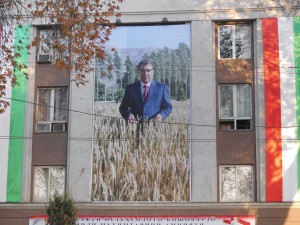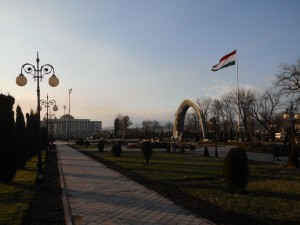The incumbent head of state, Emomali Rahmon, won another term in office on the 6th November 2013 presidential elections in Tajikistan. By the time he finishes serving in 2020, he will have been in power for a total of 28 years. At his April 2013 visit to Brussels where he met with European Commission president Jose Manuel Barroso, Rahmon emphasised his commitment to democratic reform in Tajikistan and promised that the coming presidential poll would be conducted “in a free, transparent, and democratic manner.”[i] The extent to which this commitment was fulfilled has caused debate among local and international experts.
Not too much rigging required
Apart from Rahmon, five other candidates participated in the presidential race. Over six thousand local observers and 500 international observers representing the Organisation for Security and Cooperation in Europe (OSCE), the Commonwealth of Independent States (CIS), the Shanghai Cooperation Organisation (SCO) and other bodies monitored the electoral campaign and the voting process at 3,158 polling stations. The voter turnout was high – 4.2 million, or 86 percent, of Tajikistani citizens cast their ballots, 83.6 percent of which favoured Rahmon. In the previous poll held in 2006, Rahmon received 79.3 percent of the vote with a slightly higher participation rate. In 2013, the second best candidate representing the Communist Party of Tajikistan (CPT) scored a paltry 5 percent of the vote.
The CIS Executive Secretary praised the elections’ “democratic, transparent and contested” nature, and added that “people came to the polling stations in a good and positive mood; all electors voted for the stability and prosperity of their state.”[ii] The OSCE observers begged to differ, pointing out numerous irregularities and technical shortcomings, and, more significantly, passing the verdict that the poll lacked “genuine choice and meaningful pluralism” and the campaign preceding it “was formalistic and limited voters’ opportunity to make an informed decision.”[iii]
Both positions have merit. On the one hand, the regime used the full force of state-controlled electronic media to ensure that the electorate was especially familiar with one particular candidate, dedicating 90 percent of airtime to the president’s achievements in serving the country. The regime also tightly managed the electoral space, culling potential challengers to Rahmon’s rule. In the months leading to the poll, Zaid Saidov, a former Minister for Industry and powerful businessman, was arrested and put on trial on charges of corruption and other assorted crimes after he announced an intention to form a new opposition party. On 9 December 2013 the state prosecutor demanded 28 years of imprisonment for his alleged illegal activities, which finally sparked an outcry in the privately-owned media in Tajikistan – after the elections were over.[iv] Oinihol Bobonazarova, a genuine opposition candidate from the Union of Reformist Forces incorporating the Islamic Renaissance Party (IRPT) and the Social-Democratic Party (SDPT) was denied official registration after she failed to collect the 210,000 signatures mandated by the law. Five other contestants were in many ways bogus candidates and gracefully conceded defeat calling the elections fair. One of them, the chairman of the dwarfish Democratic Party, opined that just being on the same bulletin with Emomali Rahmon was an amazing privilege and opportunity, and saw no harm in sustaining a crushing defeat.[v]
On the other hand, Rahmon ought not to have worried about the opposition at all. The outcome of the elections was never in doubt given the incumbent president’s popularity. Just like his long-serving colleagues in Kazakhstan and Uzbekistan, Rahmon is widely regarded at home as the Father of the Nation, a peacemaker who steered the country from the abyss of the civil war in the 1990s, and a wise and experienced leader who ensures stability and prosperity. All surveys in the current electoral cycle revealed a high approval rating, reaching 96 percent in the beginning of 2013.[vi] Two mainstream opposition parties, the CPT and IRPT, could boast only 6 percent of popular appeal in the most recent parliamentary elections, compared to 68 percent for Rahmon’s People’s Democratic Party.[vii]
Rahmon’s overwhelming victory accurately reflected the conviction of the absolute majority of the citizens of Tajikistan that he is the best person to lead the country for another seven years. It also illustrated the weakness of civic society in the country which failed to produce a compelling political counter-narrative challenging the regime’s authoritarianism, corruption and economic mismanagement. The creation of the Union of Reformist Forces and its attempt to nominate Bobonazarova was a last-minute affair complicated by incessant bickering between the IRPT and SDPT and the population’s apathy and disinterest in any new radical or reformist ideas. There is little evidence that Bobonazarova’s fiasco was due to the government’s machinations; the electoral commission actually gave her three extra days to collect the missing signatures, yet she still failed.
In general, it is hard to avoid the conclusion that politics in Tajikistan has become less sophisticated and more parochial since independence. The lingering trauma of the civil war and the ruralisation and de-modernisation of society must account for the excessive caution and inherent conservatism of the electorate.
The role of labour migrants and strategic alliance with Russia
A crucial resource at Rahmon’s disposal has been his image as the defender of the rights of Tajik labour migrants. Most of them go to Russia – 1.2 million Tajik citizens are working at any given moment in that country. Their remittances account for half of Tajikistan’s GDP, and they don’t have time or desire to engage in their country’s domestic politics. A week before the elections Rahmon masterminded the signing of a deal with Moscow that gives preferential treatment to Tajik guest workers in Russia. This deal was touted as the final coup in a series of concessions obtained by the President from the giant northern neighbour helping ordinary Tajiks to survive.[viii]
Rahmon’s inauguration on 16 November 2013 went smoothly; there were no protests or opposition rallies. Under the prevailing conditions, it is difficult to expect that the Tajik president will be threatened by a sudden upsurge of a popular democratic movement along the lines of the Arab Spring over the next several years. The machine of soft authoritarianism, installed and perfected by the regime, muddled through the much more difficult times of the late 1990s and the global financial crisis of 2008-2010, and will continue to do so, provided Russia props it up politically and economically. Tajikistan’s membership in the Collective Security Treaty Organisation and its desire to join the Customs Union indicate the deepening patron-client relationship between the two states that underwrites the stability of Rahmon’s government.
Rahmon’s new cabinet
This stability and continuity was underscored by the government reshuffle ordered by Rahmon after his inauguration. Similar to James Hacker from Yes, Prime Minister who ‘raised the average age of the Cabinet, but lowered the average IQ’, the Tajik president has made executive appointments based on the criterion of personal loyalty rather than ability. The average age actually dropped from 56 to 52 years, but new ministers have decidedly failed to inspire hope for change of any kind among the Tajik public. Representatives from Rahmon’s patrimony of Kulob have increased their domination of the executive. The post of prime minister, traditionally reserved for members of the northern Khojandi sub-ethnic group, went to a relative newcomer, Qohir Rasulzoda, who will not be in a position to defend the interests of his clan vis-à-vis that of the president for some time.
The consolidation and Kulobisation of power has its dangers for the regime. There is a growing resentment in the regions that are denied access to state resources. This has led to acts of civil disobedience and even low-intensity fighting in Gharm and most recently in the Pamirs where locals engaged armed units deployed by the central government.[ix] Another threat associated with Rahmon’s long neopatrimonial rule is the sheer proliferation of his extended family: he has nine children himself, and with all the uncles, aunts, nephews and their spouses counted in, the number of relatives claiming closeness to the president, and hence power, ranges between 150 and 200 at present. Rumours about vicious internecine fighting constantly circulate in Dushanbe. One of the most significant appointments made by Rahmon after the elections has been the nomination of his 26 year-old son, Rustam, to head the State Customs Committee. Local analysts have interpreted this as the president’s attempt to promote a particular group within his entourage to the detriment of all others, and commence what they called ‘operation Succession’, i.e. keeping supreme power within the family after 2020.[x] There are precedents for the establishment of dynastic rule in the post-Soviet space, of course, most notably in Azerbaijan after 2003.
Conclusion
The presidential elections of November 2013 demonstrated that Emomali Rahmon has retained a popular mandate to rule. Tajik society has continued to credit him as an ultimate peacemaker, protector and provider and has not judged him harshly on his less than sterling democratic credentials. He has been lucky on the economic development front, as export of surplus labour to Russia has generated ample rentier income that obviates the need for long-overdue reforms. A strategic partnership with Russia has also consolidated regime security in terms of protection against external threats, although the extent of Moscow’s commitment to Tajikistan may be severely tested if the situation in Afghanistan deteriorates sharply after 2014, and Tajikistan’s 1,300km border with that country becomes unstable.
It is likely to be business as usual in the next seven year term for Rahmon. Barring catastrophic events such as an open rebellion of sub-ethnic regional elites or a palace coup driven by a faction within his extended family, he may well serve it in full and pass the baton to an anointed successor. Alternatively, he may want to continue to serve the nation – he will turn 68 in 2020, a relatively young age by the standards of his fellow Central Asian presidents.
—
Dr Kirill Nourzhanov is a Senior Lecturer in Central Asian studies at the Australian National University. His most recent publication is Tajikistan: A Social and Political History. Canberra: ANU E Press, 2013 (co-authored with Christian Bleuer).
References:
[i] Quoted in Konstantin Parshin, “Tajikistan: Can Rahmon Keep Running?” Eurasianet.org, 23 April 2013, http://www.eurasianet.org/node/66869 (accessed 2 December 2013).
[ii] Sergei Lebedev, “Missiia SNG dala vysokuiu otsenku prezidentskim vyboram v Tadzhikistane”, CIS Executive Committee, 7 November 2013, http://www.cis.minsk.by/news.php?id=2258 (accessed 15 December 2013).
[iii] International Election Observation Mission Republic of Tajikistan — Presidential Election, 6 November 2013, “Statement of Preliminary Findings and Conclusions”, The OSCE Office for Democratic Institutions and Human Rights, 7 November 2013, http://www.osce.org/odihr/elections/107944 (accessed 6 december 2013).
[iv] Olga Tutubalina, “Vrag gosudarstva”, Asia-Plus, 9 December 2013.
[v] “Raqiboni rozii Rahmon az natijahoi intikhoboti 6 noiabr”, Ozodagon, 7 November 2013.
[vi] Monitoring sotsialnykh nastroenii naseleniia stran postsovetskogo prostranstva. Evraziiskii monitor: Moscow, 2013, p. 29.
[vii] International Foundation for Electoral Systems, Public Opinion in Tajikistan 2010: Findings from an IFES Survey. Washington, D.C.: IFES, 2010, p. 33.
[viii] Viktoria Panfilova, “Moskva vydala bonus Rahmonu”, Nezavisimaia gazeta, 30 October 2013.
[ix] Anora Sarkorova, “Khorugh: dar asl, chi hodisa bud?” Imruz news, 9 December 2013.
[x] “Operatsiia ‘Preemnik’?” Asia-Plus, 5 December 2013.
Further Reading on E-International Relations
- Responses From Central Asian States to the Russian Invasion of Ukraine
- Donors’ LGBT Support in Tajikistan: Promoting Diversity or Provoking Violence?
- Ukraine and Russia Gird for Presidential Election
- The Ideas Behind Putin’s War in Ukraine
- Post-Putin Russia: Five Potential Pathways
- Why Both Ukraine and Russia Need Peace after a Third Summer of War

